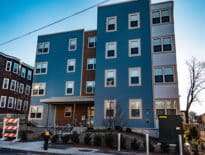
Georgia Katsoulomitis
It’s no secret that the cost of living in Massachusetts is very high – and the lack of affordable housing is a key culprit. It’s especially true for extremely low–income households. A recently released report from the Federal Reserve Bank of Boston found that in 2016, there was less than one affordable and available unit for every two extremely low-income renter households in Massachusetts.
It’s enough of a challenge for middle income families to afford to live in Massachusetts. It’s nearly impossible if you are poor.
Massachusetts is having many conversations around what to do about this housing affordability crisis. People are wringing their hands about the skyrocketing cost of everything from rents to single–family homes to urban condos. Communities still fret about creating more affordable housing in their backyards. But we aren’t having the conversations we need to have regarding housing for low income (especially extremely low–income people) and struggling working families.
The relationship between housing unaffordability or instability and poverty is undeniable and well-documented. Lack of access to stable, safe, affordable housing both drives and perpetuates a cycle of poverty. Along with financially destabilizing families, housing unaffordability and instability also has public health implications and affects the long-term development and educational attainment for children.
There’s a lot at stake, both for individual families and for us collectively as a state, when we talk about housing and housing policies. Much of the conversation has centered around housing production, which is of course critical. But to truly tackle the affordable housing shortage in Massachusetts, we must approach housing – and housing policy – from a targeted, comprehensive approach.
Baker Bill Not Sufficient
It’s easy to believe that simply producing more housing overall will alleviate the problem. An adequate supply of housing is essential, but it is important to look more closely at which income groups actually have a shortage of housing and then target solutions to those groups.
Efforts like Gov. Charlie Baker’s Housing Choice bill – which would amend state law to make it easier for local zoning boards to approve certain categories of housing – may assist in the creation of more market-rate housing in some communities. But it would not address the need for affordable housing units among the state’s poorest residents.
The National Low Income Housing Coalition reports that Massachusetts would need to produce 187,000 rental units to house its lowest income families. If we’re thinking about increasing housing production in any capacity, we must, at the same time, include the means to create affordable and supportive housing targeted to address the most acute housing shortages we face.
Let’s also examine ways to expand the public housing stock. Looking at publicly-owned land as a source is an option. This land was acquired using public funding and therefore should be used to serve the public good and presents an opportunity to expand the supply of public housing for extremely low–income households.
Preservation Needed, Alongside Production
Solving the housing crisis for low income households can’t be solved by production alone. We can’t talk about a comprehensive housing policy unless we also focus on preservation.
It is much more cost-effective to preserve existing affordable housing than to produce new housing. There’s of course the issue of expiring use that’s jeopardizing thousands of affordable units across the state. But there is also the issue of displacement. Low-income and working poor people around the state, especially in urban communities undergoing economic revitalization, are facing rapidly skyrocketing rental costs. This has resulted in household economic instability, deepening poverty, overcrowding (as families are forced to double up) and often displacement from communities they have lived and worked in for many years.
Communities and local governments must create a balance between urban revitalization and the interests of all residents, including low income families. The voices of the community in urban revitalization initiatives are critical to ensure that these efforts are equitable and benefit everyone.
These are just a few items to consider as Massachusetts and its communities plan for the future, and there are many more. As we think about what’s next in housing policy for the commonwealth, let’s make sure the needs of poor families and individuals are front and center. Access to stable, safe, affordable housing for all is not only important to the economic well-being of families, children, and communities – it is also important for the commonwealth. We’re one state, one economy – and housing policies based on principles of equity and shared prosperity benefit all of us.
Georgia Katsoulomitis is the executive director of the Massachusetts Law Reform Institute.




 |
| 
